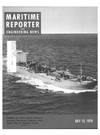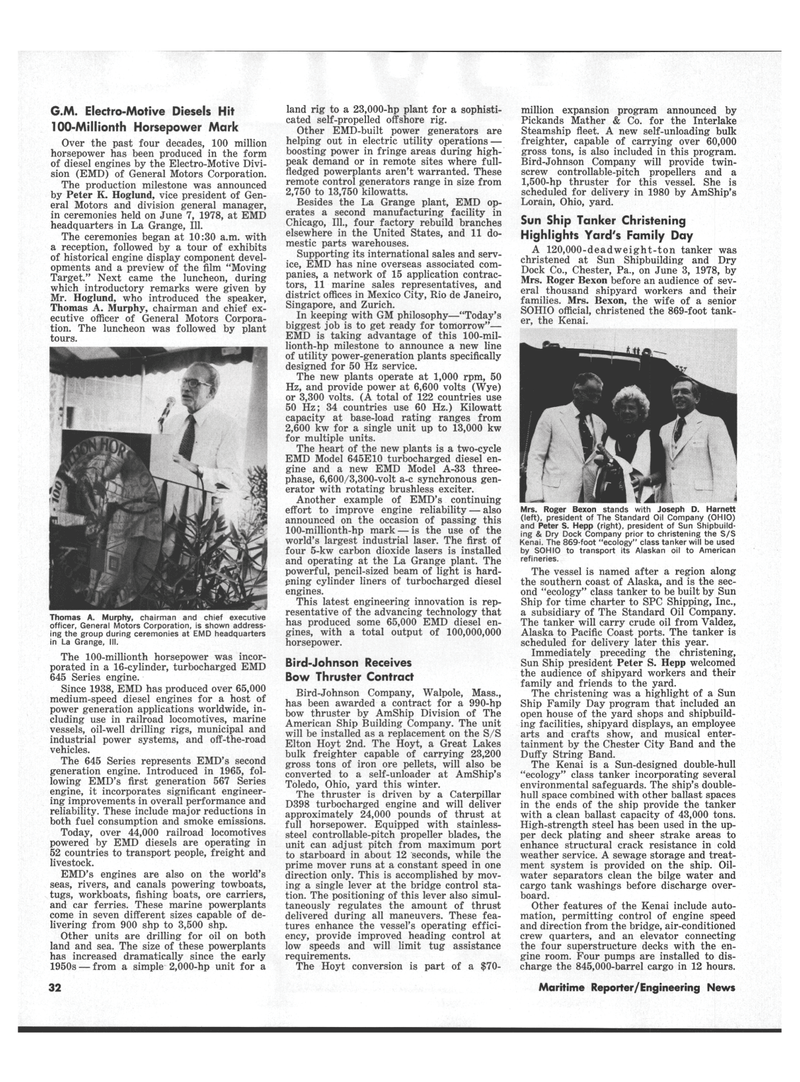
Page 30: of Maritime Reporter Magazine (July 15, 1978)
Read this page in Pdf, Flash or Html5 edition of July 15, 1978 Maritime Reporter Magazine
G.M. Electro-Motive Diesels Hit 100-Millionth Horsepower Mark
Over the past four decades, 100 million horsepower has been produced in the form of diesel engines by the Electro-Motive Divi- sion (EMD) of General Motors Corporation.
The production milestone was announced by Peter K. Hoglund, vice president of Gen- eral Motors and division general manager, in ceremonies held on June 7, 1978, at EMD headquarters in La Grange, 111.
The ceremonies began at 10:30 a.m. with a reception, followed by a tour of exhibits of historical engine display component devel- opments and a preview of the film "Moving
Target." Next came the luncheon, during which introductory remarks were given by
Mr. Hoglund, who introduced the speaker,
Thomas A. Murphy, chairman and chief ex- ecutive officer of General Motors Corpora- tion. The luncheon was followed by plant tours.
Thomas A. Murphy, chairman and chief executive officer, General Motors Corporation, is shown address- ing the group during ceremonies at EMD headquarters in La Grange, III.
The 100-millionth horsepower was incor- porated in a 16-cylinder, turbocharged EMD 645 Series engine.
Since 1938, EMD has produced over 65,000 medium-speed diesel engines for a host of power generation applications worldwide, in- cluding use in railroad locomotives, marine vessels, oil-well drilling rigs, municipal and industrial power systems, and off-the-road vehicles.
The 645 Series represents EMD's second generation engine. Introduced in 1965, fol- lowing EMD's first generation 567 Series engine, it incorporates significant engineer- ing improvements in overall performance and reliability. These include major reductions in both fuel consumption and smoke emissions.
Today, over 44,000 railroad locomotives powered by EMD diesels are operating in 52 countries to transport people, freight and livestock.
EMD's engines are also on the world's seas, rivers, and canals powering towboats, tugs, workboats, fishing boats, ore carriers, and car ferries. These marine powerplants come in seven different sizes capable of de- livering from 900 shp to 3,500 shp.
Other units are drilling for oil on both land and sea. The size of these powerplants has increased dramatically since the early 1950s — from a simple 2,000-hp unit for a land rig to a 23,000-hp plant for a sophisti- cated self-propelled offshore rig.
Other EMD-built power generators are helping out in electric utility operations — boosting power in fringe areas during high- peak demand or in remote sites where full- fledged powerplants aren't warranted. These remote control generators range in size from 2,750 to 13,750 kilowatts.
Besides the La Grange plant, EMD op- erates a second manufacturing facility in
Chicago, 111., four factory rebuild branches elsewhere in the United States, and 11 do- mestic parts warehouses.
Supporting its international sales and serv- ice, EMD has nine overseas associated com- panies, a network of 15 application contrac- tors, 11 marine sales representatives, and district offices in Mexico City, Rio de Janeiro,
Singapore, and Zurich.
In keeping with GM philosophy—"Today's biggest job is to get ready for tomorrow"—
EMD is taking advantage of this 100-mil- lionth-hp milestone to announce a new line of utility power-generation plants specifically designed for 50 Hz service.
The new plants operate at 1,000 rpm, 50
Hz, and provide power at 6,600 volts (Wye) or 3,300 volts. (A total of 122 countries use 50 Hz; 34 countries use 60 Hz.) Kilowatt capacity at base-load rating ranges from 2,600 kw for a single unit up to 13,000 kw for multiple units.
The heart of the new plants is a two-cycle
EMD Model 645E10 turbocharged diesel en- gine and a new EMD Model A-33 three- phase, 6,600/3,300-volt a-c synchronous gen- erator with rotating brushless exciter.
Another example of EMD's continuing effort to improve engine reliability — also announced on the occasion of passing this 100-millionth-hp mark — is the use of the world's largest industrial laser. The first of four 5-kw carbon dioxide lasers is installed and operating at the La Grange plant. The powerful, pencil-sized beam of light is hard- ening cylinder liners of turbocharged diesel engines.
This latest engineering innovation is rep- resentative of the advancing technology that has produced some 65,000 EMD diesel en- gines, with a total output of 100,000,000 horsepower.
Bird-Johnson Receives
Bow Thruster Contract
Bird-Johnson Company, Walpole, Mass., has been awarded a contract for a 990-hp bow thruster by AmShip Division of The
American Ship Building Company. The unit will be installed as a replacement on the S/S
Elton Hoyt 2nd. The Hoyt, a Great Lakes bulk freighter capable of carrying 23,200 gross tons of iron ore pellets, will also be converted to a self-unloader at AmShip's
Toledo, Ohio, yard this winter.
The thruster is driven by a Caterpillar
D398 turbocharged engine and will deliver approximately 24,000 pounds of thrust at full horsepower. Equipped with stainless- steel controllable-pitch propeller blades, the unit can adjust pitch from maximum port to starboard in about 12 seconds, while the prime mover runs at a constant speed in one direction only. This is accomplished by mov- ing a single lever at the bridge control sta- tion. The positioning of this lever also simul- taneously regulates the amount of thrust delivered during all maneuvers. These fea- tures enhance the vessel's operating effici- ency, provide improved heading control at low speeds and will limit tug assistance requirements.
The Hoyt conversion is part of a $70- million expansion program announced by
Pickands Mather & Co. for the Interlake
Steamship fleet. A new self-unloading bulk freighter, capable of carrying over 60,000 gross tons, is also included in this program.
Bird-Johnson Company will provide twin- screw controllable-pitch propellers and a 1,500-hp thruster for this vessel. She is scheduled for delivery in 1980 by AmShip's
Lorain, Ohio, yard.
Sun Ship Tanker Christening
Highlights Yard's Family Day
A 120,000-deadweight-ton tanker was christened at Sun Shipbuilding and Dry
Dock Co., Chester, Pa., on June 3, 1978, by
Mrs. Roger Bexon before an audience of sev- eral thousand shipyard workers and their families. Mrs. Bexon, the wife of a senior
SOHIO official, christened the 869-foot tank- er, the Kenai.
Mrs. Roger Bexon stands with Joseph D. Harnett (left), president of The Standard Oil Company (OHIO) and Peter S. Hepp (right), president of Sun Shipbuild- ing & Dry Dock Company prior to christening the S/S
Kenai. The 869-foot "ecology" class tanker will be used by SOHIO to transport its Alaskan oil to American refineries.
The vessel is named after a region along the southern coast of Alaska, and is the sec- ond "ecology" class tanker to be built by Sun
Ship for time charter to SPC Shipping, Inc., a subsidiary of The Standard Oil Company.
The tanker will carry crude oil from Valdez,
Alaska to Pacific Coast ports. The tanker is scheduled for delivery later this year.
Immediately preceding the christening,
Sun Ship president Peter S. Hepp welcomed the audience of shipyard workers and their family and friends to the yard.
The christening was a highlight of a Sun
Ship Family Day program that included an open house of the yard shops and shipbuild- ing facilities, shipyard displays, an employee arts and crafts show, and musical enter- tainment by the Chester City Band and the
Duffy String Band.
The Kenai is a Sun-designed double-hull "ecology" class tanker incorporating several environmental safeguards. The ship's double- hull space combined with other ballast spaces in the ends of the ship provide the tanker with a clean ballast capacity of 43,000 tons.
High-strength steel has been used in the up- per deck plating and sheer strake areas to enhance structural crack resistance in cold weather service. A sewage storage and treat- ment system is provided on the ship. Oil- water separators clean the bilge water and cargo tank washings before discharge over- board.
Other features of the Kenai include auto- mation, permitting control of engine speed and direction from the bridge, air-conditioned crew quarters, and an elevator connecting the four superstructure decks with the en- gine room. Four pumps are installed to dis- charge the 845,000-barrel cargo in 12 hours. 32 Maritime Reporter/Engineering News

 29
29

 31
31
